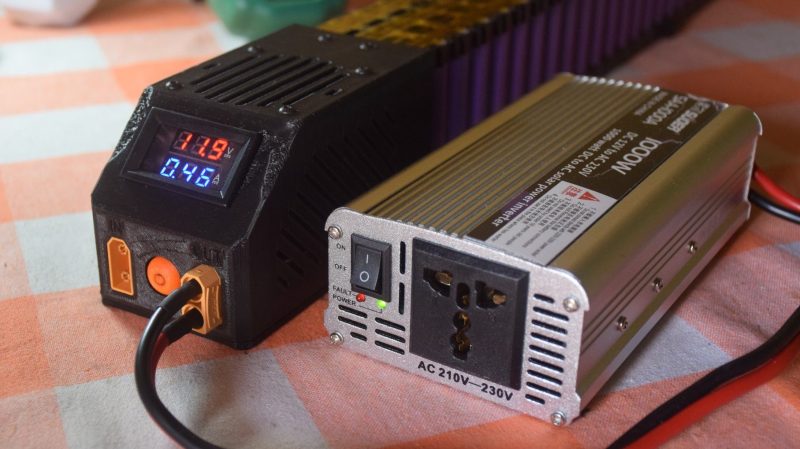These days, we’re all running around toting smartphones and laptops that could always use a bit more charge. Portable battery packs have become popular, and [Anuradha] has designed one that packs plenty of juice to keep everything humming.
The pack is designed to be charged via solar panels, at 18 V and up to 5 A of current. It’s intended to work with a Maximum Power Point Tracking module to ensure the maximum energy is gained from the sunshine available. For storage, the pack relies on 75 individual 18650 lithium cells, arranged with 3 cells in series, each with 25 in parallel (3s25p). They’re spot welded together for strength and good conductivity. Nominally, the output voltage is on the order of 10-12 V. The included battery management system (BMS) will allow an output current up to 100 A, and the pack can be used with an AC inverter to power regular home appliances.
Overall, it’s a tidy pack that’s more than capable of keeping a few devices charged up for days at a time. If you’re building something similar yourself, though, just be sure to package it well and keep it protected. So many lithium batteries can quickly turn fiery if something goes wrong, so store and use it appropriately! Fear not, however – we’ve got a guide on how to do just that.



















I wonder what the logic was behind choosing 3s rather than 6s. Halving the current to the inverter would be a big win – 42A instead of 83A – not least because the tails and connectors they’re using don’t look capable of carrying anything like that. (Think car starter motor wiring gauge).
That looks like a simple requirement of the 12v inverter he is using.
Based on the looks of that inverter, it will supply 1000w for about 1 microsecond before it destroys itself…. so…. there is that. Assuming it could supply 1000w, that wire size is definitely too small. I’m guessing it’s maybe #12 or #10. I’m not sure I’d even push #10 wire for the primary of a 500w 12v inverter.
On another note, I would expect the reason for the choice of 3s is because the sole reason for the build is not only to power an inverter, but any number of things, which are much more readily available as a consequence of the automotive accessory market and therefore are mostly centered around 12v.
But you’re right, if the cost of the inverter is a non issue, and the cell count can be adjusted (6s would not divide into 75, but 78 would, etc), you could even use a 48v inverter and include a buck converter to give you 12v…
In other words: how to introduce a major fire hazard into one’s home.
Does someone know an AC inverter that can synchronize with mains voltage?
I only find cheap ones which don’t sync or very expensive one that do everything (but I don’t want to pay for non desired features).
At that point i’m thinking to just make one myself but it astonish me that one doesn’t exist already at a reasonable price!
You want to build a DIY grid tie inverter? The reason they’re expensive off-the-shelf is, in part, due to the fact that they need (really *need*) to be certified for G100/99/98 compliance to prevent linesmen dropping like flies. For compliant, inexpensive models – search for “Mastervolt” or “Windsave”.
Very Much NOT a recommendation…
but they do exist from the unregulated foreign import market: https://a.co/d/0LC5Zzc
#scary
@wibble We have solar panel that generates 220v trough a MPPT. The excess of energy is redirected to water heater with a diy PV router. My father built a battery pack to power the house. To charge it easy, a simple relay will do. But to power the house our current setup is to use a spare MPPT which has 220v synchronization and mains detectection (to respect de certification I believe). Problem is that you can’t control how much energy is going in the house, either it’s on or off (and the MPPT takes 30 sec to sync back to the main if you cut the power). We tried with a buck-boost between the battery and the MPPT, but the buck-boost are dying like flies haha (And I don’t like the idea of the buck boost trying to regulate it’s output while the MPPT continuously varies it’s input).
So what I’m seeking is an 220V AC inverter with main detection et synchronization which can take 48v or more input, and I would just slap a Buck Boost to regulate how much power goes it the house.
Or maybe there is already an opensource project that I can just modify to my needs, didn’t really find any.
Otherwise, thanks for the links and the infos!
@Amazon Buyer: Thanks for the link maybe it will be a good/cheap base to modify and add all the security features!
Why would something which is commercially available in a single box, ie better, be subject to a prize?
Noting that the inverter is commercial off the shelf and it’s built up of modules and not even put into a finished box !?
18V solar panels hmm non standard then
Isn’t it better to use a quality Smart UPS for that? I am currently building myself 48V 100Ah Li-Ion battery pack 13s35p to use with my UPS that I already own. It’s one of these but older model:
https://www.apc.com/shop/hr/en/products/APC-Smart-UPS-Line-Interactive-3kVA-Rackmount-2U-230V-8x-IEC-C13-1x-IEC-C19-outlets-SmartConnect-Port-SmartSlot-AVR-LCD/P-SMT3000RMI2UC
You could find second hand – used one for cheap without batteries and that will solve synchronisation with AC voltage problem.